TreeviewCopyright © aleen42 all right reserved, powered by aleen42
Project Cost Management Back
- Overrun is the additional percentage or dollar amount by which actual costs exceed estimates.
- Project cost management includes the processes required to ensure that the project is completed within an approved budget.
1. Processes
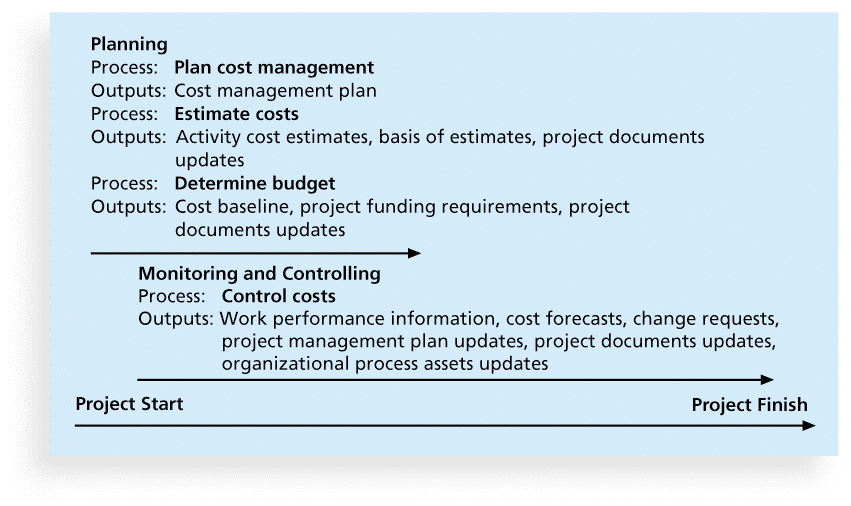
- Planning cost management
- To use expert judgment, analytical techniques, and meetings to develop the cost management plan.
- Estimating costs
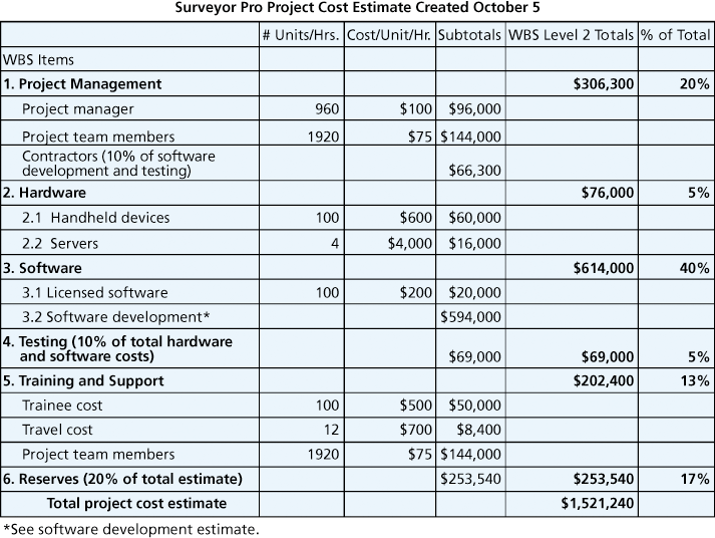
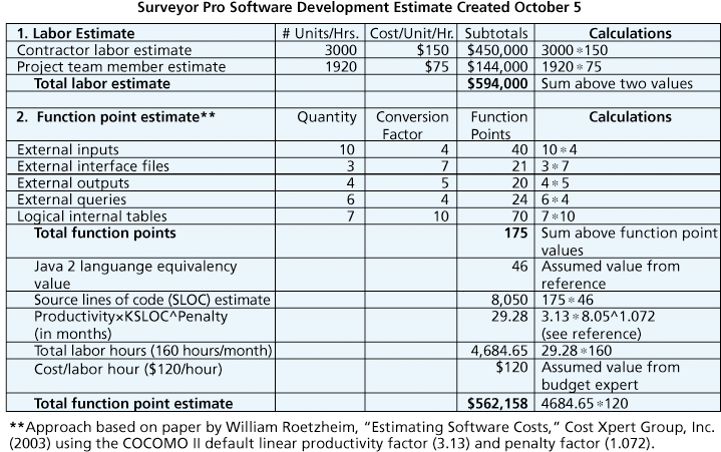
- Types:
- Rough Order of Magnitude(ROM): often 3~5 years before.
- Budgetary: often 1~2 years before.
- Definitive: often less than 1 year.
- Tools:
- Analogous or top-down estimates: use the actual cost of a previous, similar project as the basis for estimating the cost of the current project.
- Bottom-up estimates: involve estimating individual work items or activities and summing them to get a project total.
- Parametric modeling(參數化建模) uses project characteristics (parameters) in a mathematical model to estimate project costs.
- Types:
- Determining the budget
- Cost budgeting involves allocating the project cost estimate to individual work items over time.
- The WBS is a required input to the cost budgeting process since it defines the work items to produce a cost baseline.
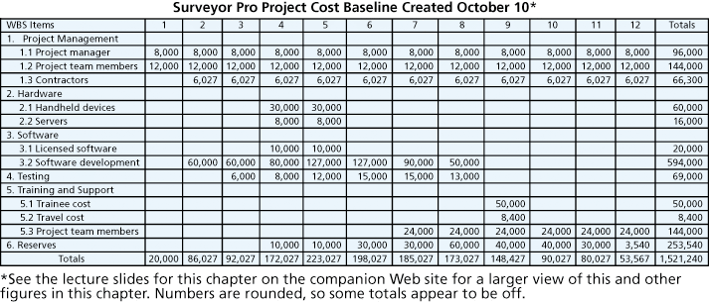
- Controlling costs
2. Basic Principles of Cost Management
- Profits are revenues(收入) minus expenditures(支出).
- Profit margin(利润率) is the ratio of revenues to profits.
- Life cycle costing considers the total cost of ownership, or development plus support costs, for a project.
- Cash flow analysis determines the estimated annual costs and benefits for a project and the resulting annual cash flow.
- Learning curve theory states that when many items are produced repetitively, the unit cost of those items decreases in a regular pattern as more units are produced.
- Reserves are dollars included in a cost estimate to mitigate(降低) cost risk by allowing for future situations that are difficult to predict.
- Contingency(偶然性) reserves allow for future situations that may be partially planned for (sometimes called known unknowns) and are included in the project cost baseline.
- Management reserves allow for future situations that are unpredictable (sometimes called unknown unknowns).
3. Definitions
- Tangible(有形的) costs or benefits are those costs or benefits that an organization can easily measure in dollars.
- Intangible costs or benefits are costs or benefits that are difficult to measure in monetary(貨幣的) terms.
- Direct costs are costs that can be directly related to producing the products and services of the project.
- Indirect costs are costs that are not directly related to the products or services of the project, but are indirectly related to performing the project.
- Sunk cost(沉沒成本) is money that has been spent in the past. (When deciding what projects to invest in or continue, you should not include sunk costs)
4. Measured Values
- Earned Value Management(EVM) is a project performance measurement technique that integrates scope, time, and cost data.
- Planned value(PV), formerly called the budgeted cost of work scheduled(BCWS), also called the budget, is that portion of the approved total cost estimate planned to be spent on an activity during a given period.
- Actual cost(AC), formerly called actual cost of work performed(ACWP), is the total of direct and indirect costs incurred in accomplishing work on an activity during a given period.
- Earned value(EV), formerly called the budgeted cost of work performed(BCWP), is an estimate of the value of the physical work actually completed.
- Rate of performance(RP) is the ratio of actual work completed to the percentage of work planned to have been completed at any given time during the life of the project or activity.
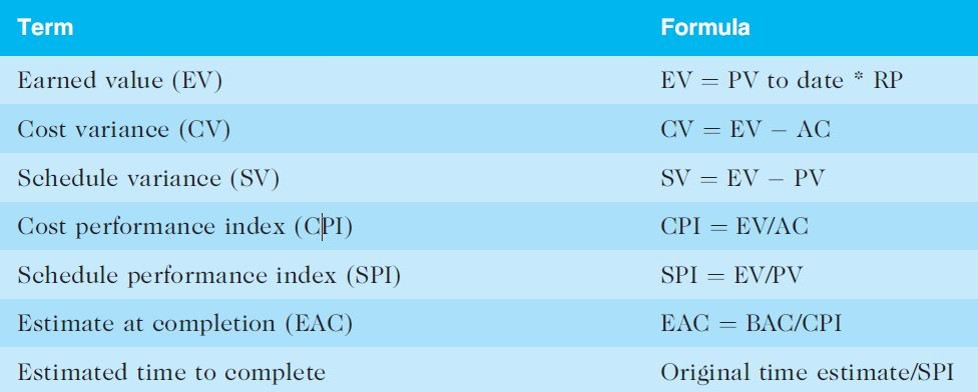
- rules:
- CPI(EV/AC) and SPI(EV/PV) less than 100% indicate problems. (Problems mean the project is costing more than planned (over budget) or taking longer than planned (behind schedule)
- the Estimate At Completion(EAC) is an estimate of what it will cost to complete the project based on performance to date.
- the Budget At Completion(BAC) is the original total budget for the project.
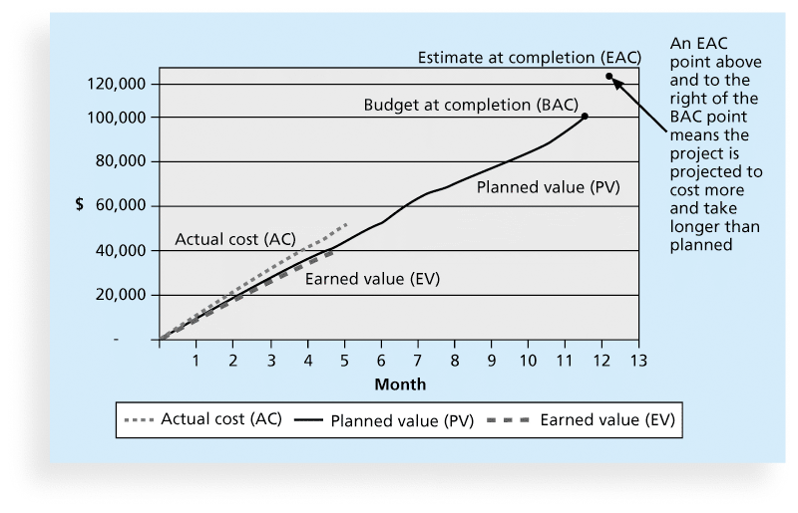
5. Portfolio Management
- Five levels for project portfolio management:
- Put all your projects in one database
- Prioritize the projects in your database
- Divide your projects into two or three budgets based on type of investment
- Automate the repository
- Apply modern portfolio theory, including risk-return tools that map project risk on a curve(曲線)
6. Q&A
- Work performance information and cost forecasts are main outputs of the which process?
- cost budgeting
- cost control
- cost estimating
- cost pricing
answer: cost control.
- Soles is a footwear company which has recently set up its store in Ambrosia. To manufacture its products, Soles incurs a range of different costs. Which of the following would be an example of an indirect cost?
- Cost of machines to produce shoes
- Electricity used to run its factories
- Salary paid to factory workers
- Cost of leather used to manufacture shoes
answer: Electricity used to run its factories.
- Which of the following is true of contingency reserves?
- They allow for future situations that can be partially planned for.
- They are not included in a cost baseline.
- They are also known as unknown unknowns.
- They allow for dollar amounts to be used to cover existing, fixed costs.
answer: They allow for future situations that can be partially planned for.
- Which of the following is true of bottom-up estimates?
- They are based on the actual cost of a previous, similar project.
- They are most accurate when they involve large, extensive work items.
- They are also known as parametric estimating.
- They are time-intensive and expensive to develop.
answer: They are time-intensive and expensive to develop.
- Which of the following is most likely to be a reason for inaccuracies in information technology cost estimates?
- Estimates take a long time to be worked out.
- Human beings are biased toward overestimation.
- People lack estimating experience.
- Only software development provides the scope for estimates to be accurate.
answer: People lack estimating experience.
- Which of the following is an output of the process of controlling costs?
- Cost forecasts
- Basis of estimates
- Project funding requirements
- Scope baselines
answer: Cost forecasts.
- Which of the following is an input of the process of controlling costs?
- Cost forecasts
- Change requests
- Work performance data
- Scope baseline
answer: Work performance data.
As the plugin is integrated with a code management system like GitLab or GitHub, you may have to auth with your account before leaving comments around this article.
Notice: This plugin has used Cookie to store your token with an expiration.